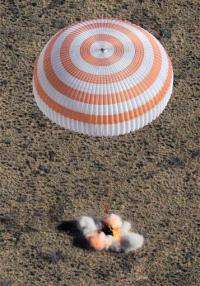Soyuz lands safely in Kazakhstan, rattles nerves

(AP) -- A Russian Soyuz capsule carrying three returning astronauts from the International Space Station touched down safely Friday in the central steppes of Kazakhstan, but not without rattling nerves after a breakdown in communications.
NASA astronaut Ron Garan and Russian cosmonauts Andrei Borisenko and Alexander Samokutyayev landed some 150 kilometers (93 miles) southeast of the city of Zhezkazgan at 10 a.m. local time (0400 GMT) after 164 days in space.
Repeated calls to the Soyuz TMA-21 capsule from Mission Control in Korolyov, outside Moscow, went unanswered for several minutes, well after the craft had de-orbited. Communication was eventually established between the crew and an Antonov fixed-winged aircraft circling the landing site.
The landing was smooth in the area planned seconds before the expected arrival time.
Russian cosmonaut Sergei Volkov, NASA's Michael Fossum, and Satoshi Furukawa of Japan's JAXA space agency remain onboard the international space station and are due to return to Earth on Nov. 22.
There will be some taut nerves in the run-up to that return, which Roscosmos announced Friday should be preceded by a manned Soyuz launch from Baikonur on Nov. 14. Earlier this week, Roscosmos announced that the launch was to take place on Nov. 12.
Russia's space agency, Roscosmos, had to postpone that launch from October amid concerns over a failed supply mission last month. Another delay would almost certainly mean the space station would have to be left unmanned. Astronauts have been living aboard the station, without interruption, for almost 11 years.
Since phasing out the U.S. space shuttle program earlier this year, NASA is relying entirely on Russia to get American and other astronauts to the international space station.
On Friday, Russian space officials mounted their well-rehearsed search-and-recovery operation for Soyuz landings, deploying 14 Mi-8 helicopters in a holding circular pattern, as well as more than half a dozen all-terrain vehicles.
"What these helicopters do is that they sort of arrive at a targeted area and hover for a bit until they get a confirmation of exactly where the Soyuz has landed. But we actually did not hover at all today, we came straight in to the landing site," said NASA spokesman Josh Byerly, speaking from the landing site.
Samokutyayev, who occupied the central seat in the capsule, was the first to be pulled out and hoisted into a medical chair. He look visibly drained, but in good spirits, as a nurse mopped his brow and checked his blood pressure.
A beaming Garan was hoisted out a few minutes later, shortly followed by Borisenko.
The three men were then carried in their reclining seats into an inflatable medical tent positioned some 30 meters (30 yards) away, where they were to change out of their entry suits into more comfortable clothes ahead of their return home.
Around them, jubilant Russian space officials exchanged congratulations and posed for photographs. Some fixed a photo of Russian space pioneer Yury Gagarin together with seminal rocket designer Sergei Korolyov, after whom the Moscow mission control is named.
Helicopters will first take the three men to the Kazakh city of Karaganda, after which Samokutyayev and Borisenko will fly on to the Chkalovsky airport, near Moscow, while Garan will leave directly for the United States with a NASA support crew.
Russian Mission Control could not secure direct audio communication in the period between the Soyuz capsule de-orbiting and landing. A mission control official repeatedly called out their call-sign, "Tarkhany," and appealed for a response, but received no answer.
Still, a beeping signal indicated that the module separation process had been completed. Minutes before landing, an aircraft awaiting their craft's arrival reporting seeing the parachute deploy and shortly afterward a flying Antonov aircraft command center received the message that the crew was well.
The capsule landed gently around 30 seconds before 10 a.m. local time (0400 GMT) in the barren steppe, throwing up a puff of dust, before rolling onto its side.
While it is not unusual for the capsule to be pulled onto its side, it makes pulling out the crew a slightly lengthier process.
Their craft carrying the returning crew was dubbed the Gagarin, as they began their trip to the space station from the Baikonur spaceport in southern Kazakhstan on April 4, just eight days shy of the 50th anniversary of Yury Gagarin's maiden voyage into orbit.
©2011 The Associated Press. All rights reserved. This material may not be published, broadcast, rewritten or redistributed.




















